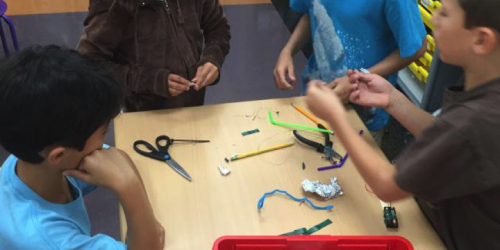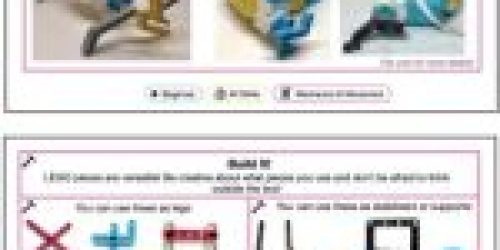We are always looking to hear about what is going on with our local teachers and ask that you send us what you have been working on in your classroom. Melanie Flores, a CEEO Newsletter subscriber, shares her work on Kindergarten Engineering Design Workshops, originally posted on the Kingsley Montessori School website on July 26, 2016.
by Melanie Flores
What happens when you combine the energy and imagination of a kindergartener with the engineering design process? As an educator and a former engineer, I could stand in front of students and describe the engineering design process all day long, but there’s no replacement for learning by doing. This year, Kingsley Montessori School piloted a Kindergarten Engineering Design Workshop to introduce a new spin on our science fair model. True to our school’s value of “innovation through collaboration”, all of our early childhood educators joined hands to bring the workshop to life.

Our goal was for every kindergartener to experience the engineering design process through a personally meaningful hands-on project resulting in a prototype, a journal of their work, and a formal presentation for peers, parents, and faculty. We drew inspiration from two Boston-area neighbors: the Massachusetts Institute of Technology and the Museum of Science.

Nothing embodies MIT’s motto mens et manus (“mind and hand”) better than course 2.007, the Institute’s famous Design and Manufacturing class for mechanical engineering undergraduates. I can still picture mechanical engineering classmates working on their projects at all hours of the night. As I set forth to develop an engineering offering for our Early Childhood Program, I remembered their grit and perseverance and asked myself, “Why couldn’t five- and six-year-olds do this?”
To make it child-friendly, I took cues from the Museum of Science’s Engineering is Elementary® program and Engineering Design Workshop; both invite children to build prototypes with ordinary household materials such as pipe cleaners and coffee filters. Because the components are everyday objects, students are already familiar with their properties and can focus on figuring out how to combine them to solve problems.

Thus our Kindergarten Engineering Design Workshop was born. Kingsley kindergarteners became engineers for three weeks, using the engineering design process (EDP) as a road map. We used the EDP developed as part of the Museum of Science’s Engineering is Elementary® program which consists of five steps: Ask, Imagine, Plan, Create, and Improve. We chose shoes as the design project because they appeal to boys and girls alike, and they offer many avenues for creativity in both form and function.
After examining and comparing their own shoes, the Kindergarteners unanimously agreed that no shoe, no matter how “cool,” is worth wearing if it does not stay on your foot! They developed two measurable design criteria:
- The shoe must stay on your foot when you jump ten times.
- The shoe must stay on your foot when you walk across the room.
Once their shoes passed these two specifications, the students were welcome to upgrade their designs for functionality, comfort, and appearance.
Upon receiving their “standard parts kits” – large zippered bags containing cardboard, bubble wrap, and other household scraps – the students imagined possible shoe designs and sketched plans. “No cutting or gluing without a plan!” was our mantra.

After reviewing their plans with me, the kindergarteners were off to the races! Hot glue guns and sharp scissors emerged from cabinets. In every corner, children were measuring, tracing, cutting, and assembling with laser focus. They giggled as they performed the jump test, and cheered one another on during the walk test. After testing, students made beelines back to their tables to tweak – and in some cases, overhaul – their designs; one boy even asked to skip recess so he could continue working on his prototype. Once their designs were complete, the children documented their work thoroughly in journals that captured not just the learning but also the joy they gleaned from their work.
No two shoes were alike; from sandals to boots, the variety was stunning. One thing, however, was universal – the immense ownership demonstrated by every student.
The workshop culminated in a showcase in which every student gave an individual formal presentation to their parents and peers. Who could have imagined five- and six-year-olds willingly standing alone in a dark room in front of a large group – including adults – using a projector and a screen, explaining their work, and fielding questions? No note cards were used, and nothing was memorized. For many it was the first time formally speaking in public, yet they did it with pride, grinning ear-to-ear.
Our kindergarteners’ accomplishments serve as a shining example of what is possible when students are deeply engaged in their learning, and at Kingsley we strive to provide this opportunity to our friends on a daily basis. The students’ creativity, enthusiasm, and confidence inspired everyone at our school. In this program, forty young children succeeded in transforming scraps into shoes…and in the process, discovered the budding engineers, writers, and speakers within themselves.



